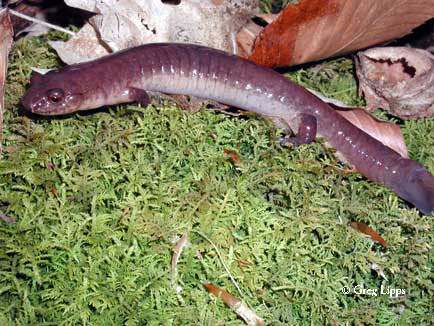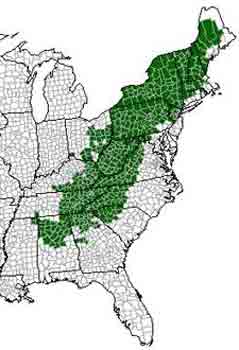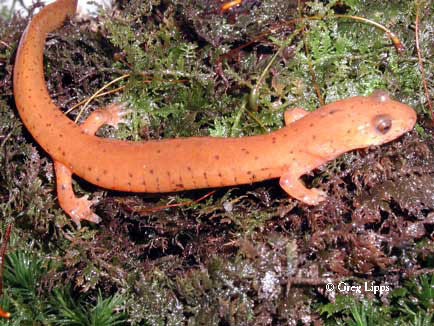
Spring Salamander
(Gyrinophilus porphyriticus ssp.)
 |
||
 |
 |
|
|
Distribution of the Spring Salamander (from the AR MI Atlas)
|
A Northern (top) and Kentucky (bottom) Spring Salamander. Note that color variation is more likely due to age than subspecies.
|
|
Description: A large (up to 9”) stout-bodied salamander with a ground color ranging from salmon to pinkish orange. Black spots, flecks, or mottling are present on the body, but may be obscured in older, darker animals. The belly is usually clear. A light line runs from the eye to the nostril, then to the upper lip. This line is usually bordered by darker pigment. |
||
Distribution in Ohio: There are two subspecies in Ohio. The Kentucky Spring Salamander (Gyrinophilus p. duryi) is limited to an area west of the Scioto River in Adams, Scioto, Highland, and Pike Counties. The Northern Spring Salamander (Gyrinophilus p. porphyriticus) is found in eastern Hamilton County and in eastern Ohio, south of the Wisconsin glacial boundary. |
||
|
|
||
Status in Ohio: The Spring Salamander is not a state listed species. |
||
|
|
||
Habitat: Springs, seeps, spring-fed headwater streams, caves, and other cool, clear waters free of predaceous fish. In these areas the Spring Salamander is found under rocks, logs, and within burrows in the water and at its edge. |
||
|
|
||
Life history: Eggs are laid in the summer, attached singly to the underside of a rock within a spring. They hatch later that summer or in the fall. The aquatic larval period lasts 3-4 years. |
||
|
|
||
Conservation: Spring Salamander populations rely on clear, cool springs, seeps, and headwater streams. Their permeable skin makes them especially susceptible to pollution, such as pesticides, herbicides, runoff, and acid mine drainage. Removal of trees around springs, seeps, and headwater streams may negatively impact populations by increasing temperatures and evaporation. Forested areas around these water sources are also important for foraging. |
||
Last modified:
|
Ohio Amphibians · Ohio Salamander Web · Ohio Salamander Species · Amphibian Habitats · Salamander Monitoring |
|